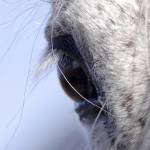Donkeys Aren’t Horses

Though donkeys are becoming more popular as pets, many equine veterinarians have not routinely treated donkeys, according to a paper presented at an American Association of Equine Practitioners conference.
Donkeys and horses have many anatomical and metabolic differences, some of which are quite important from a veterinary care standpoint. Donkeys may need about one and a half times as large a dose of some common drugs as horses do, including many products used for pain management, sedation, and general anesthesia. This is not true for guaifenesin, however. If this muscle relaxer is given to a donkey at the dose used for a horse, respiratory arrest may follow.
The muscular structure of a donkey’s neck makes it more difficult to access the jugular vein, and inserting an intravenous catheter can be made easier if local anesthetic and a surgical incision are used. Placing a tube through the mouth to the trachea is also more difficult than in horses. Donkeys have excess tissue in the pharynx, elongated laryngeal saccules (these are partly responsible for the smaller equine’s amazing vocalizations), a pocket in the throat called the pharyngeal diverticulum, and a larynx that is situated at a different angle than that of the horse. The donkey’s nasal passages are also smaller than those of a horse, and intubation is more difficult for this reason.








